Josh is currently in Israel, the lucky duck, so in honor of his trip I’m going to write about the time we made falafel using the fava beans from our CSA share. Falafel is pretty popular in Israel, although the version we made was actually Egyptian falafel, called ta’amiya. While falafel is more commonly made from chickpeas, we fell in love with the fava bean ta’amiya while we were on our honeymoon in Egypt.
The fava beans we got from the CSA were still in the pods, so first we had to split the pods open and remove the beans. The beans, however, were encased in a tough, thick skin that we needed to peel off before we could eat them. These were a pain in the butt to peel and took a long time. We basically had to carefully cut through the shell without cutting too deeply into the bean itself, and then use our fingers to break the skin off. If you can get shelled fava beans, I suggest going with those!
We based our recipe from this one that we found on the Food Network site. We improvised a bit because we didn’t have everything on hand, but they still turned out really well. This is what we used, which made six falafel balls:
– 1 lb fava beans still in pods
– 2 small cloves garlic
– 1 large handful parsley (we actually ran out of parsley and used carrot greens instead, which worked great and had a similar grassy flavor)
– 1 small bunch chives (we didn’t have scallions)
– 1/2 teaspoon cumin
– 1/2 teaspoon baking powder
– 1/2 teaspoon salt
We ground up the beans, garlic, chives, and greens in the food processor, then mixed in the cumin, baking powder, and salt. It should have a paste-like consistency.
Josh toasted up some sesame seeds in a pan, which we used to coat the falafel balls. We also ground up a handful of the seeds with some olive oil to make a sort of tahini sauce, though it wound up being slightly too bitter. Next time I’ll just buy pre-made tahini sauce.
To make the balls, I wet my hands a little and then scooped up some of the falafel mixture and rolled it into a sphere using the palms of my hands. Then I flattened it a little to make a patty shape, and then rolled it in the toasted sesame seeds. I repeated the process until I used up all of the mixture.
We heated up some vegetable oil in our dutch oven to fry the falafel balls. We wanted to deep fry them so we probably had about 3-4 inches of oil in the pot. While the oil was heating up, I put the falafel balls in the fridge to firm up a bit. Then I carefully dropped them in one by one into the hot oil. Once they were nicely browned, I pulled them out and put them on paper towels to drain.
I cut one of the balls in half to make sure they were cooked through, and it was beautifully green and creamy in the center.
To serve, we heated up some pita bread in the oven, then cut them in half to expose the pockets. We filled each pocket with a few falafel balls, plus chopped lettuce and tomatoes. Then we drizzled some of the homemade tahini sauce on top. It was pretty freakin’ delicious, I have to say. The falafel was really flavorful and had great texture. They were crispy on the outside and moist in the middle. We could taste the fava beans and the herbiness of the carrot greens, while the cumin bound everything together. We were extremely pleased with how these turned out.
Since we had oil ready for deep frying, I couldn’t resist making a batch of homemade french fries. It was easy – just cut a few potatoes into french fry shapes. You can make them as thick or as thin as you want. Fry them up in batches so they have enough room to get crispy on the outside. Drain on paper towels and season with salt and pepper immediately. Eat while they’re warm and fresh out of the oil.
I would absolutely make this falafel again, though like I said, I would buy fava beans that are already shelled. Yes, the fresh favas tasted fantastic, but I don’t know if they were worth the work. It really was a huge pain to have to shell all of them, and I just don’t have the patience. If you’ve never tried ta’amiya, definitely give this recipe a shot. It’s really easy to make (once the favas are shelled), and it’s a nice change of pace from the standard chickpea falafels. I haven’t found any restaurant yet that serves our beloved Egyptian style falafels, so if anyone has any suggestions, please let me know! But for now, I can just make them on my own and be completely satisfied.
Tags: Falafel, Fava Beans, Fries
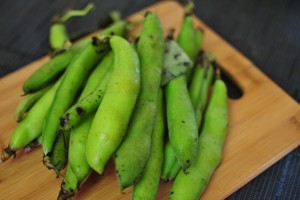
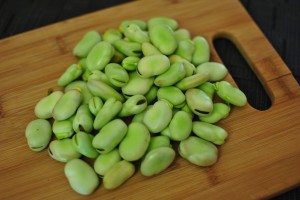
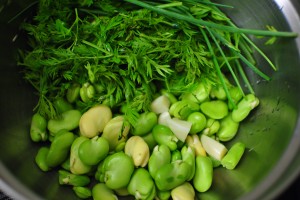
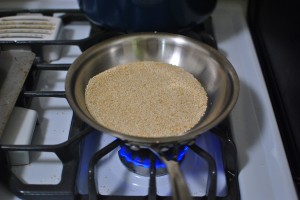
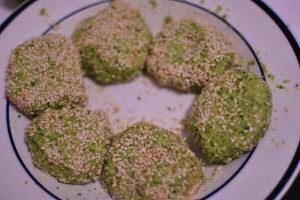

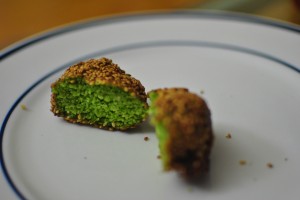
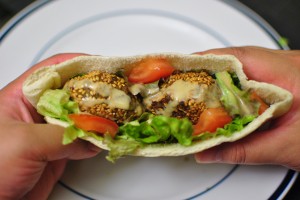
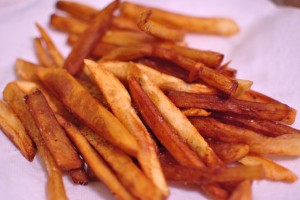
We grow our own favas (in Northern Virginia, USA). After shucking the bean from the pod, just par-boil the beans one minute, shock them in cold water, and peel the skins by using a light fingernail pressure to get a start. Very easy. Many of the skins will have burst; even easier.
Favas are easily grown by sowing the seed in the Fall (Autumn); they will sprout, grow, go dormant in the winter, and burst forth in the spring. They will be ripe in May-June. (US zone 7a: 0 – 5 degrees F., -15 — -17 degrees C.)
There are few disease or insect problems (the bean is from Europe; no indigenous fava pests here in the USA). But beware; fava plants are large; 5 feet tall, 3 feet in diameter, and need staking.
Buy seeds via internet.
Jon
You don’t really need to do the double shelling. Just take ’em out of the pods and par boil, and then grind them up without removing the soft shell. It’s a little chewy, but once it goes through the processor it’s hardly noticeable. Don’t fear the fiber.
Yes, they cook anyway the fava-beans up to one hour in salt water before they mash them, after that it is very easy (but then you don’t need to) to peel the skin off.
I liked very much this Falafel from Egypt.